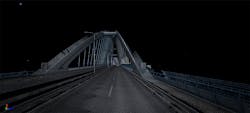Maximizing Mobility
By Vicki Speed, Contributing Author
Mobile mapping technology has become a mainstay in the construction space over the last decade as a resource for visualizing as-built conditions.
More recently, it’s become an essential component of digital workflows for owners, especially transportation agencies, engineers, and contractors. The data derived from mobile mapping technology is bringing more safety, efficiency, and productivity to all processes, from engineering design to asset management.
According to a recent SmartMarket Brief, one of the top challenges that project team members, including owners, face is the ability to understand the root causes of issues that arise during construction. In contrast, one of the top benefits of technology and a digital workflow is that owners and project teams can make better-informed decisions.
Cyndee Hoagland, senior vice president in charge of Trimble’s owner and public sector group, said: “The industry is learning to do more with data gathered in the field, particularly high accuracy mobile mapping data, which is enabling more coordinated designs, improved construction planning with fewer change orders and establishing a foundation for maintenance activities.”
Advances such as 5G, simultaneous localization and mapping (SLAM), artificial intelligence (AI) and deep learning are mapping the future of this continually evolving field.
Laser Focused
Like any technology, mobile mapping solutions are more accurate, and data is richer with improved software for processing and feature registration.
ESP Associates, a multi-disciplinary engineering design and consulting firm, has been using mobile scanners for more than a decade.
Ryan C. Swingley, geomatics manager at ESP, said, “We cut our teeth on one of the industry’s first mobile mapping systems in 2010,” said Ryan C. Swingley, geomatics manager at ESP Associates. “Now we have a suite of these data collection solutions from various manufacturers.”
The firm uses the technology to capture high-accuracy, survey grade data, and enterprise-wide assets, including integrating a mobile mapping system with a pavement collection van for comprehensive data collection—from pavement to assets in the right of way.
Deliverables include base mapping for autonomous vehicle operation, electrical and communication lines, and geospatial intelligence for numerous other applications. One ongoing ESP project that began in the fall of 2021 requires daily subsidence monitoring for a utility bore under a busy section of interstate using mobile LiDAR.
“This project was a culmination of modern mobile technology for us because we had to manage some unique restrictions,” Swingley said. “We were not allowed to have anyone on the roadway, even for control. With today’s mobile mapping technology, we were able to use fixed features, in this case bridge piers, to constantly register our data to those same points. Better yet, we are able to get unbelievable repeatability that I never would have thought possible.”
Swingley’s team established key points from a baseline mobile scan and then checked those same points daily for successive scans. “We achieved 0.002 feet of consistency on those critical points providing exceptional confidence on the quality of our data,” he said.
The Workflow Incentive
Beyond technology advances such as high-quality IMUs for continuous millimeter accuracy, mobile mapping platforms are more versatile. They can be used on all types of vehicles, from trucks and ATVs to train and tram lines.
“Like any technology, these solutions are also more accurate, and data is richer with better quality—and most importantly, the data is easier to use in the larger connected digital workflow,” said Marco Belò, product manager of the Trimble Mobile and Terrestrial Scanning team. “A common request from our customers is the need to improve data collection and processing efficiency. It’s imperative that we simplify the processing from initial point cloud management to feature extraction."
In Italy, the roadway maintenance subsidiary of the Adige Bitumi Group relied on a mobile mapping system to prepare for the reconstruction of the SS38 motorway between Bolzano and Merano. The survey team set up a control network with reference points about every 200 meters along the stretch of motorway. The team used a vehicle-mounted mobile mapping solution to capture roadway data along the entire route.
The point cloud data was then processed using 3D point cloud processing software. From there, the project team moved the data to the road design programs to create a digital model of the road surface, which was then uploaded to a 3D milling system on a Wirtgen milling machine to mill with the set precision per design to obtain an optimal final surface.
Emphasizing Deliverables
When you look at mobile mapping, the hardware is important, but the software is the key.
Automatic and semi-automatic feature extraction procedures are helping mobile mapping operators. However, depending on the size of the captured data and the specific needed deliverable, a significant processing time should be considered.
Belò notes that one hour of mobile mapping collected data requires approximately three hours of data processing. “The goal is a one-to-one ratio of collection to production,” he said.
Belò believes that deep learning and AI can help on the processing side, while the cloud and 5G will likely facilitate the transfer of large datasets from the field to the office or to the cloud, where dedicated feature extraction services will significantly improve processing time.
Dedicated AI algorithms enable automated detection and extraction of features, like road signs or lamp posts. This information can be extracted from the LiDAR dataset, from collected imagery, or from a combination of both data sources.
With more real-time data, owners will also realize benefits, as issues that arise during design and construction can be resolved much quicker with clear, visible data about existing conditions. R&B
Vicki Speed is a freelance writer specializing in the construction space.
